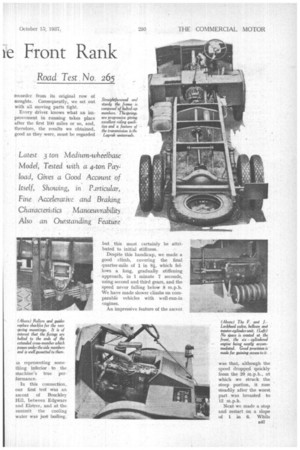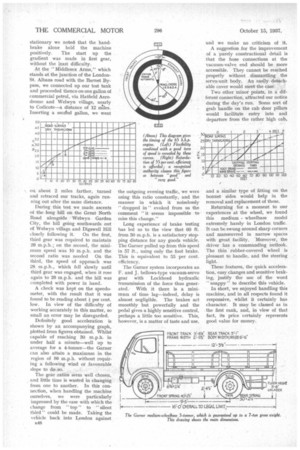The Garner Gains a Place ii
Page 64

Page 65

Page 66

If you've noticed an error in this article please click here to report it so we can fix it.
le Front Rank
Road Test No 265
DISTINCTIVE in many respects —appearance, performance, n-iauceuvrability and carrying capacity—the Garner mediumwheelbase (9 ft. 3 ins.) 3-tonner, that forms the subject of this road-test report, has many points to recommend it to operators.
It is covered by a 50 per cent. overload guarantee and can, accordingly, be classed for purposes of comparison with. 4-}-tonners. It is available in three other wheelbase lengths : long, .11, ft. tin.; extra long, 12 ft. 11 ins., giving a body space of 17 ft. 5t ins.; and short, 7 ft. 5 ins., for :tippers. Weighing well under 2.4i tons, it comes comfortably within the 30 m.p.h. speed limit.
Among its special claims for consideration in a crowded and keenly competitive market are the exception
ally forward driving Position, which gives excellent vision and a big body space whilst keeping down the overall length in relation to wheelbase ; the means provided for easily drawing forwards out of the frame the radiator, engine and gearbox as a unit, and the well-known Garner patented swinging wing and removable footplates for giving good access to the engine without withdrawing it.
Besides these, there are countless other attractive features of design which contribute towards the machine's first-class performance and its qualities of durability.
As a single example, a suspension detail might be mentioned. Instead of shackles, sliding spring ends are used, the top leaves bearing on rollers and working between closely fitting hardened-steel guides. This is claimed to give smooth riding and to minimize wear. We can confirm the former claim.
For a further instance of accessibility, we might quote the mounting of the propeller-shaft centre bearing under the cross-member instead of behind it, so that the complete shaft with its Layr ub rubber universals and the bearing may be detached bodily.
Prior to our test the Garner had been run off the assembly line, filled up with fuel and loaded, and had travelled a distance insufficient to 'alter the speedometer distance recorder from its original row of noughts. Consequently, we set out with all moving parts tight.
Every driver knows what an improvement in running takes place after the first 100 miles or so, and, therefore, the results we obtained, good as they were, must be regarded ts representing some thing inferior to the machine's true performance.
In this connection, our first test was an ascent of Brockley Hill, between Edgware and Elstree, and at the summit the cooling water was just boiling, but this must certainly be attributed to initial stiffness.
Despite this handicap, we made a good climb, covering the final quarter-mile of 1 in 81, which follows a long, gradually stiffening approach, in 1 minute 7 seconds, using second and third gears, and the speed never falling below 8 m.p.h. We have made slower climbs on comparable vehicles with well-run-in engines.
An impressive feature of the ascent was that, although the speed dropped quickly from the 20 m.p.h., at which we struck the steep portion, it rose steadily after the worst part was breasted to 12 m.p.h.
Next we made a stop and restart on a slope of 1 in 6. While *347 stationary we noted that the handbrake alone held the machine positively. The start up the gradient was made in first gear, without the least difficulty.
At the " Middlesex Arms," which stands at the junction of the LondonSt. Albans road with the Barnet By pass, we connected up our test tank and proceeded thence on one gallon of commercial petrol, via Hatfield Aerodrome and Welwyn village, nearly to Codicote—a distance of 12 miles. Inserting a seccfnd gallon, we went on about 2 miles farther, turned and retraced our tracks, again running out after the same distance.
During this test we made ascents of the long hill on the Great North Road alongside Welwyn Garden City, the hill going southwards out of Welwyn village and Digswell Hill closely following it. On the first, third gear was required to maintain 20 mph.; on the second, the minimum speed was 10 m.p.h. and the second ratio was needed On the third, the speed of approach was 28 m.p.h., which fell slowly until third gear was engaged, when it rose again to 20 m.p.h. and the hill was completed with power in hand.
A check was kept on the speedometer, with the result that it was found to be reading about i per cent. low, In view of the difficulty of working accurately in this matter, so small an error may be disregarded.
Definitely good acceleration is shown by an accompanying graph, plotted from figures obtained_ Whilst capable of reaching 30 m.p.h. in under half a minute—well up to average for a 4-tonner—the Garner can also attain a maximum in the region of 50 m.p.h without requiring a following wind or favourable slope to do so.
The gear ratios seem well chosen, and little time is wasted in changing from one to another. in this connection, when handling the machine ourselves, we were particularly impressed by the ease with which the change from "top " to "silent third" could be made. Taking the vehicle back into London against B4S the outgoing evening traffic, we were using this ratio constantly, and the manner in which it noiselessly "dropped in" evoked from us the comment "it seems impossible to miss this change."
Long experience of brake testing has led us to the view that 60 ft. from 30 m.p.h. is a satisfactory stopping distance for any goods vehicle. The Garner pulled up from this speed in 57 ft., using only the foot brake. This is equivalent to 55 per cent. efficiency.
The Garner system incorporates an F. and J. bellows-type vacuum-servo gear with Lockheed hydraulic transmission of the force thus generated. With it there is a minimum of time lag—indeed, delay is almost negligible. The brakes act smoothly but powerfully and the pedal gives a highly sensitive control, perhaps a little too sensitive. This, however, is a matter of taste and use, and we make no criticism of it.
A suggestion for the improvement of a purely constructional detail is that the hose connections at the vacuum-valve end should be more accessible. They cannot be reached properly without dismantling the servo-unit body. An easily detachable cover would meet the case.
Two other minor points, in a different connection, attracted our notice during the day's run. Some sort of grab handle on the cab door pillars would facilitate entry into and departure from the rather high cab, and a similar type of fitting on the bonnet sides would help in the removal and replacement of these.
Returning for a moment to our experiences at the wheel, we found this medium wheelbase model extremely handy in London traffic. It can be swung around sharp corners and manceuvred in narrow spaces with great facility. Moreover, the driver has a commanding outlook. The thin rubber-covered wheel is pleasant to handle, and the steering light.
These features, the quick acceleration, easy changes and sensitive braking, justify the use of the word " snappy " to describe this vehicle. In short, we enjoyed handling this machine, and in all respects found it responsive, whilst it certainly has character. It may be classed as in . the first rank, and, in view of that fact, its price certainly represents good value for money.




































































































